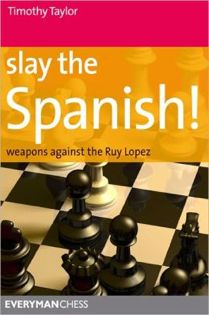Slay The Spanish
Tim Taylor

Los Angeles IM Tim Taylors latest book, SLAY THE SPANISH, is the first book that this reviewer is aware of that is devoted to the Modern Steinitz (1.e4 e5 2.Nf3 Nc6 3.Bb5 a6 4.Ba4 d6) against the Ruy Lopez.
The Modern Steinitz was a favorite of the late Paul Keres and Taylor credits the Great Estonian with showing the viability of this defense at the highest level (T.T. has Keres with a lifetime record of +27, =28, -4!). Taylor also points out the practicality of the Modern Steinitz which steers play into Blacks choosing unlike, for example, the Marshall Attack which allows White many ways to vary before the second player is able to play 8 d5.
Taylor covers a lot of ground in his book including the following: lines which are examined in 85 heavily annotated model games.
2 Solid Line I: The Knight Defense (5.0-0 Bd7 6.c3 Nge7 7.d4 Ng6) page 54
3 Solid Line II: The Bishop Defense (5.0-0 Bd7 6.d4 Nf6 7.c3 g6 8.Nbd2 Qe7) 73
4 The Siesta (5.c3 f5) 102
5 The Yandemirov Gambit (5.0-0 Bg4 6.h3 h5) 143
6 Delayed Exchange Variation (5.Bxc6+ bxc6 6.d4 exd4) 173
7 The Duras Variation (5.c4 Bg4) 194
8 White Plays an Early d2-d4 (5.d4) 206
9 Four Fishes 227
10 Ruy Exchange, Main Line with 4…dxc6 240
11 Ruy Exchange, Larsens Variation: 4…bxc6 260
While the bulk of this work is devoted to the Modern Steinitz, it is Taylors recommendation against the Exchange Ruy Lopez that is likely to attract the most attention. The author has had some bad experiences playing against 1.e4 e5 2.Nf3 Nc6 3.Bb5 a6 4.Bxc6, bad enough that he feels something radical is needed to combat Whites attempts to follow long theoretical lines where the second player is left playing for a draw.
One might think his proposal would be the newly-fashionable gambit 1.e4 e5 2.Nf3 Nc6 3.Bb5 a6 4.Bxc6 dxc6 5.0-0 Bg4 6.h3 Bh5 7.g4 Bg6 8.Nxe5 Qh4 featured in New in Chess Yearbook 93, but they would be mistaken. What Taylor has in mind is sometime much more novel 4 …bxc6!
The move, played by Alekhine and used several times by GMs Krasenkov and G. Kuzmin, is hardly unknown but theory has always considered it inferior in part because the Modern Steinitz sequence 1.e4 e5 2.Nf3 Nc6 3.Bb5 a6 4.Ba4 d6 5.Bxc6+ has always been considered a respectable try for an advantage for White and after 4… bxc6 Black can easily find himself in a situation in which he is a tempo down as White has traded straightaway on c6 and not lost time with Bb5-a4Xc6+. Indeed Krasenkov met 5.0-0 with 5 …Qf6 precisely to avoid this fate but Taylor isnt having any of it. First he thinks that the Modern Steinitz move-order 1.e4 e5 2.Nf3 Nc6 3.Bb5 a6 4.Ba4 d6 5.Bxc6+ is nothing after 5… bxc6 6.d4 exd4 and second he feels that even with an extra tempo White has nothing after 4 …bxc6. This is definitely butting heads with conventional theory.
Its true that after 1.e4 e5 2.Nf3 Nc6 3.Bb5 a6 4.Bxc6 bxc6 5.d4 and 5.0-0 Black can take advantage of the fact that the delay in development allows some increased flexibility in the form of Qf6. That Ne7-g6 in place of Nf6 sometimes facilitates c5 as the Knight on e7 stops Whites Nc6-a5 tying Black up. Maybe this makes up for the lost tempo or at least keeps Whites edge to a minimum, but what about 5.Nc3?
The idea of this move is to put the question to the e-pawn and force Black to commit to 5 …d6 while still preserving Whites options to answer d4 exd4 with either Qxd4 or Nxd4 as well as castling short or potentially long. Taylor considers 5.Nc3 a sideline and gives the following analysis 5… d6 6.d4 exd4 7.Nxd4 (no analysis of 7.Qxd4) 7. Ne7! ( the author) 8.0-0 c5 9.Nf3 Ng6 10.Bg5 f6 11.Be3 Be7 12.Qd5 Rb8 13.Rab1 Qd7 14.Rfd1 Qe6 15.a3 0-0 16.b4 f5! (- the author) – and Black had good counterplay in Comp.Fritz 11 – T.Taylor, Los Angeles 2010, but if 12.Qd5 doesnt stop Black from castling why play it? Why not 12.Nd5 instead which looks better for White? Its unlikely that Taylor can fully resurrect 4 bxc6 but more power to him for trying.
The author of several opening books, Taylor is known for his personal style, which combines plenty of analysis and explanatory prose in an unmistakable mix. There is no mistaking a Taylor book in which his unwavering optimism is ever present. That said sometimes his enthusiasm leads to a less than objective view. For example in the last game of the book (F.Kunzner – B.Sahl the former Bjarke Kristensen) Taylor writes after 4 …dxc6 5.0-0 d6 6.d4 exd4 7.Qxd4 c5 8.Qd3 Ne7 Aronian and Rosentalis couldnt even make a half point between them from this position with White! This is literally true but the Rozentalis game is from 1980 and that with Aronian from 1995 not exactly when they were household names.
SLAY THE SPANISH will meet the needs of amateur players from 1800 to 2400 quite well.
